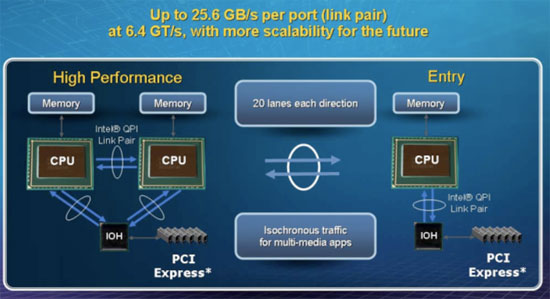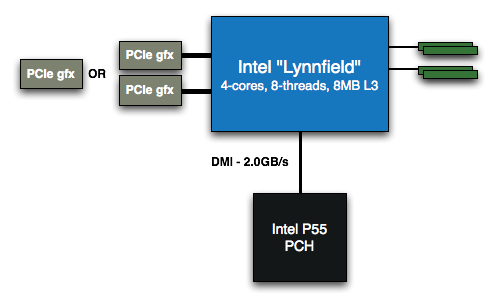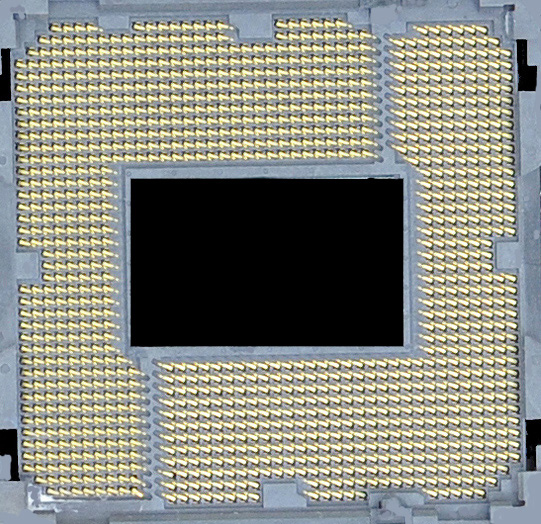The Lynnfield Preview: Rumblings of Revenge
by Anand Lal Shimpi on May 29, 2009 1:00 PM EST- Posted in
- CPUs
Making Nehalem Affordable: LGA-1156
Take the Core i7, shave off one memory controller and replace the high bandwidth QPI link with Intel’s slower DMI and you’ve got the makings of a (more) mainstream Nehalem.
Many have been calling this processor the Core i5 although I’m not quite ready to jump on that bandwagon, so I’ll keep referring to it by its socket (LGA-1156) or codename (Lynnfield).
Intel’s QPI is a very fast bus delivering up to 25.6GB/s of bandwidth. The image below shows you how Intel sees it being useful:

If you’ve got a multi-socket system (e.g. dual processor Xeon workstation, or Skulltrail successor) or if you’ve got a lot of high bandwidth PCIe devices (e.g. multi-GPU or lots of Larrabees) then QPI makes a whole lot of sense. However, if you’ve got a single socket system and aren’t running a lot of high bandwidth PCIe devices then QPI is overkill.
Intel’s DMI is the link used between the X58 chipset and the ICH10 I/O controller, it’s a much more conservative bus capable of delivering 2 - 4GB/s of bandwidth. That’s enough bandwidth for things like SATA and USB but a single PCIe x16 slot can deliver 16GB/s of bandwidth, far too much for Intel’s DMI.
Instead of crippling graphics on its mainstream platform, Intel did the next best thing and integrated 16 PCIe 2.0 lanes onto the die of its mainstream Nehalem part.
What you get looks like this:

A Lynnfield system only need two chips (CPU + PCH) while a Bloomfield system needs three (CPU + IOH + ICH)
The 16 PCIe 2.0 lanes can be configured as one x16 or two x8, allowing you enough bandwidth and very low latency to do things like CrossFire or SLI. Any additional PCIe lanes will branch off of what Intel is now calling the Platform Controller Hub (PCH). The first PCH is Intel’s P55 chipset; all you need is a Lynnfield CPU and the P55 PCH, no additional ICH is necessary as all of that functionality is embedded in the PCH.
The price of Intel’s P55 PCH is also much lower than the X58 chipset, in fact P55 is expected to be price competitive with P45 + ICH10. In other words, we should eventually see P55 boards priced at $100 or less.
Getting rid of QPI and one of the three DDR3 channels knocked down the pin-count of LGA-1366, but adding in 16 PCIe 2.0 lanes brought it back up to 1156 which you can count in the socket below:

I’ve blacked out the motherboard around it and the caps in the middle to protect the innocent.










95 Comments
View All Comments
Depeche - Friday, May 29, 2009 - link
Man thats ancient ... ya I would defiantly wait for the Core i5s. To get a Core i7 just doesn't seem worth it now with the Core i5's coming out.Samus - Friday, May 29, 2009 - link
i7 still makes sense if you plan ona) SLI/CF
b) dual-CPU
c) memory bandwidth intensive tasks (seeding torrents, folding@home, etc) where triple channel makes some sense
d) the need for 6 memory slots
e) something currently purchasable
I also suspect the release of "i5" chips will drive down prices of i7, specifically the i7-920, the most desirable i7. Keeping in mind the i7-920's overclocking ability, it is still much more capable than the "i5" even if you assume the "i5" overclocks as well, because the i7 has Jackson technology active across its entire lineup.
DJMiggy - Monday, June 1, 2009 - link
I swear I read that the i7 doesn't support dual CPUs. Maybe that has changed with xeons though or I might just be insane. Probably the latter.wifiwolf - Sunday, May 31, 2009 - link
i7 system is too expensive, cpu is also expensive but system is too overpriced.Jabbernyx - Friday, May 29, 2009 - link
^ This, although for me personally (b) isn't important and I've effectively nerfed (d) by using an EX58-UD3R :P